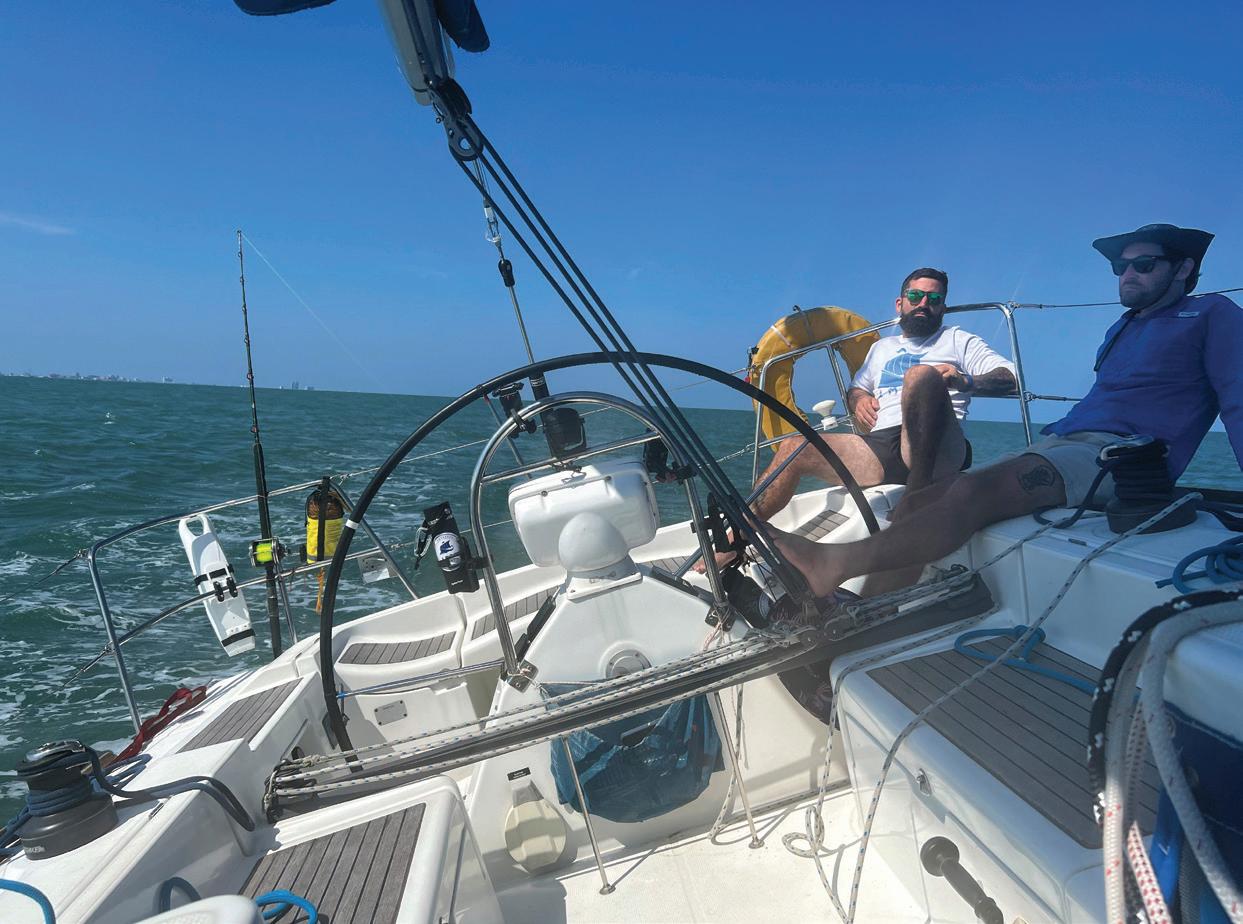
9 minute read
Transformation and Therapy: Veterans at Sea
The author, relaxed at the helm of his Cooper 416 while cruising in British Columbia in early 2022.
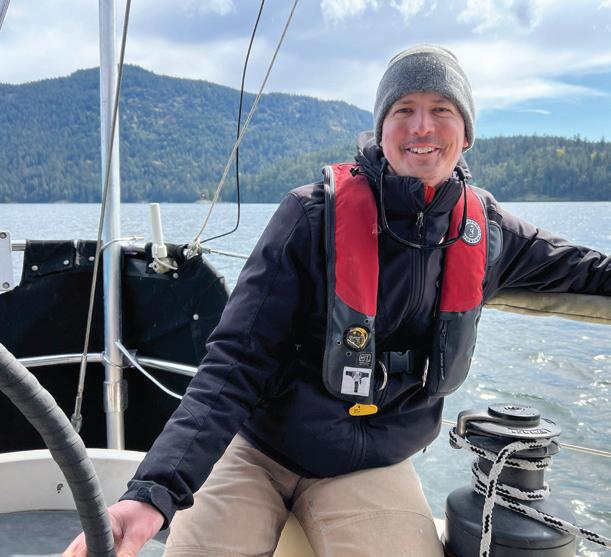
by Justin Cronin
Ifind peace on the sea. As a Marine Corps veteran who served in Afghanistan, this is a special thing for me and something that I want to share. I grew up sailing small boats on the East
Coast and learned to sail larger keelboats while stationed in
California. We lived in the high desert but would drive three hours to San Diego to rent a sailboat and escape the heat.
When I completed active duty and my wife and I were looking for a next place to land, the Pacific Northwest’s sailing potential drew us here. It took a few years before we made the jump to purchase and then live aboard our Cooper 416, but now we’ve been enjoying it for three-and-a-half years and even added an 80-pound dog to the crew.
Sailing and living on a boat in the Salish Sea has been transformational for me. The ability to link adventure with quiet time in nature is unmatched. At times, it has taken all my focus and skill, along with our Cooper’s seaworthiness, to push through heavy weather in the Strait of Georgia or Strait of Juan de Fuca. Yet, we have also been rewarded with quiet spring days when we were the only boat in anchorages like James Bay on
Prevost Island — one of our favorites.
A part of the joy for me is the work of maintaining and repairing a boat, as well as planning for trips by poring over 28
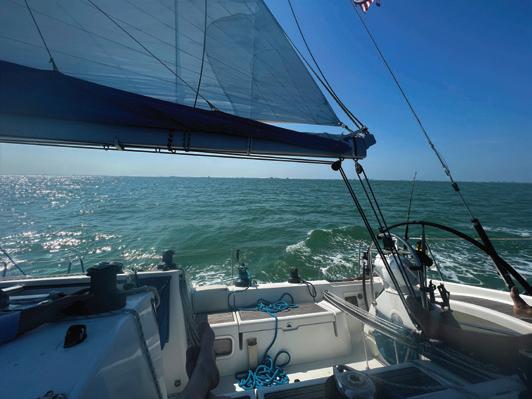
charts, guides, and weather models. Not only does it remind me of time spent preparing vehicles and gear in the Marines while planning every detail of a patrol, but it allows for continuous growth, learning, and improvement. While these experiences on the water have given me so much, I continue to seek ways to share the adventure and peace of sailing with other veterans. I’ve spent time looking for the right way to sail with other veterans and usually struck out.
Though it would take me far from my home waters, over the spring, I stumbled upon the perfect match that focused on the adventure and healing of sailing — an organization in Texas called Skeleton Crew Adventures. Within a few months, I found myself on an overnight watch with three other Marines discussing preparations for an adventure race around the world.
After my initial contact with Skeleton Crew, they reached out to see if I would be interested in joining them for the 2023 Ocean Globe Race (OGR). I was familiar with the race and was shocked by the possibility of joining. The OGR is a retro roundthe-world sailing race on the 50th anniversary and in the spirit of the original 1973 Whitbread Round the World Race. This includes the route mostly through the Southern Ocean around the Cape of Good Hope, Cape Leeuwin, and Cape Horn. To keep the full spirit and adventure, the race will be on production boats designed before 1988 and without the aid of GPS and other technologies that weren’t available in the 1973 race. After submitting my sailing resume and having a Zoom interview with the skipper and Executive Director, I was rostered for the second of the four race legs from South Africa to New Zealand.
My attention immediately turned to training, preparation, and a desire to meet more of the team. I got onto Skeleton Crew Adventure’s schedule and signed up to join six other OGR race team members on a short offshore passage in the Gulf of Mexico. I arrived on a Wednesday in June to face the Texas heat and meet some of the team. The crew of seven included three Skeleton Crew staff members (one that will be our race skipper), a Navy veteran with significant sailing experience that will be our first mate, and two Marine veterans that had almost no sailing experience. Despite a variety of experience on the water, the crew came together immediately with our shared past experiences, interest in adventure, and tough work ethic. We spent the evening getting to know each other and preparing our Beneteau First 44.7 for departure the next day.
In the morning, we pulled out of Kemah to start the overnight sail to Port Aransas. I was thankful for my wide brimmed hat and long-sleeved sun shirt as the Texas heat picked up. Coming from the Northwest, I was not used to the Gulf of Mexico’s strong sun and warm water. To be honest, the heat reminded me of my time in the Marine Corps, and the years I spent training and living in California’s Mojave Desert. I was ready for it and knew how to take care of myself, but it did make me miss the cool breeze, trees, and numerous islands of the Salish Sea.
The trip started with a long motor into the wind through Galveston Bay. We raised the mainsail while heading southeast between barges and shrimp boats. Once we rounded the jetty at Galveston, we turned south and killed the engine. We unfurled the full genoa, and the sailing began.
The first moments when the engine is off and the boat is With 12 knots of breeze and a close reach, it was easy to trim the boat for balance and speed.
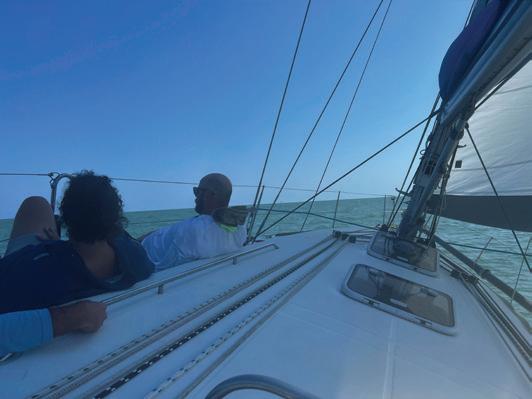
cutting smoothly through water are my favorites. It was special to share that with the two first-time sailors, and to watch as they began to understand the peace that was possible at sea. We trimmed the sails for a close reach and continued our course south down the coast and farther offshore. The wind blew around 12 knots and made it easy to balance the boat and consistently move at 7 knots or better. We had to explain to the newer sailors that the flat water and consistent wind was not something you get everyday, and was described by our skipper as the “champagne sailing” that clients always expect.
We continued along the coast about 10 miles offshore. Since I mostly cruise in the Pacific Northwest, it was unique for me to sail out of sight of land. Instead of navigating Puget Sound’s islands, rocks, and logs, we stayed busy avoiding oil platforms and fishing boats. Another surprise coming from the deep inlets of the Northwest was that 10 miles off the Texas coast, the water was only 60 feet deep.
During the afternoon, the wind began to shift and change in velocity. With a full crew and well-equipped boat, we adjusted sail trim for each shift. As the sun went down, the wind continued to build and we put a reef in the large mainsail; soon, we added a second. All of these were great opportunities to get the new sailors experience, and we rotated roles as adjustments were
The view was a little different, and so was the heat, off the coast of Texas. The author missed the islands and cool breezes of the Salish Sea.
The evening’s sunset brought a calm and ease to all aboard as they enjoyed the peaceful motion and security of a capable crew at sea.
made. The Beneteau First 44.7 was very responsive and we were able to see the effects of small changes to the headsail lead position or tension in the backstay.
By morning, the wind was light, so we shook out our reefs. We were sailing mostly closehauled now, and we tacked a few times throughout the second day to stay farther out to sea while following the southward curve of the Texas coast.
In the afternoon the wind built again, and we picked up speed toward Port Aransas. The greatest thrill of the sail was being on the wheel and coming back towards the coast in 20 knots of steady wind. I was just able to dip the starboard toe rail into the water while the crew made fine adjustments to the main sheet. It felt good to be on the helm, but also to be a part of a smoothly operating team that was in sync with the boat and conditions. The whole crew hollered as we raced the sun into port looking forward to cold drinks and a full night of sleep. We arrived in Port Aransas 30 hours after we departed Kemah.
After recuperating in port, the return trip north came with a better point of sail and plenty of wind. The crew had come together and there was a rhythm to our movements around the boat. The evening’s sunset brought a calm and ease to us all as we enjoyed the peaceful motion and security of a capable crew at sea.
That night, I got another part of what I was looking for. My four-hour night watch with other Marines and a cup of coffee reminded me of a different type of watch in very distant places. Instead of being on guard for attacks in the night, this time we enjoyed the tranquility of the sea and had time to reflect. Conversations covered tough times, funny encounters, regrets, and families we’re grateful for now. As we re-entered Galveston Bay and relished a broad reach toward the marina, the team was looking to the next challenge.
Those four days on the Gulf were just a taste of the real adventure and challenge that we were looking for. The real chemical and biological changes of adventure therapy come from engaging in a challenge that requires much of the focus, fast thinking, and problem-solving we’ve developed previously.
Our attention turned to the possibility of the OGR and preparing a crew and boat for the Southern Ocean. There are some real hurdles to overcome over the next year — from a lot of fundraising to a major refit. We have a full crew with a variety of experience that needs sea time and survival courses. For me, this brings the familiarity of readying a team for an overseas deployment, with a variety of skills to build and equipment to prepare. We have an idea of what the Southern Ocean may bring, but must prepare the boat and crew for the unexpected.
As I enjoyed dinner with our first mate back in Kemah, the race and adventure were starting to feel real. I had just witnessed the on-the-water transformation of two veterans who were new to sailing, and our plan was coming together. We had a budget and fundraising goal, and a training plan to get started. We got one evening off and then it was time to get back to work.
Now that I’m home in the Pacific Northwest, I’m grateful to be surrounded by some of the best training grounds and a community of skilled sailors. I found myself applying some sail trim techniques I learned on the Gulf during a recent trip across Puget Sound to Liberty Bay. In addition to dedicated training with the OGR crew, we’re planning some longer trips up the Sunshine Coast on our Cooper to build broader experience.
I’m excited about new challenges that lie ahead. I still appreciate the peace and healing of sailing, and am eager to see what transformations even bigger adventures may bring to me and these other veterans.
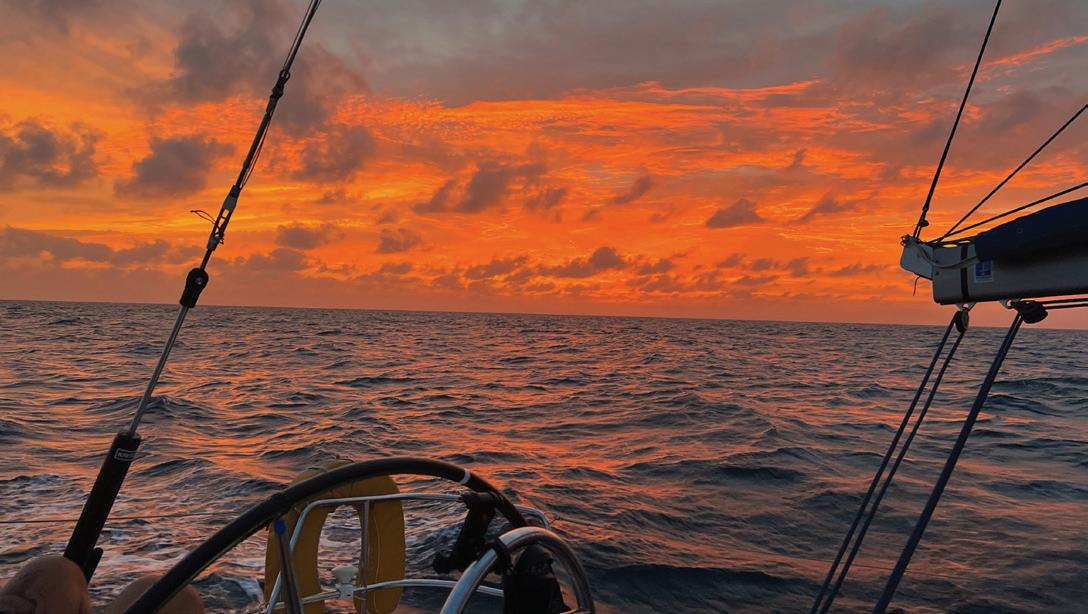
Justin Cronin is a Marine veteran that lives and cruises with his wife and 80lb dog on a Cooper 416 out of Seattle, WA. He also sails with Skeleton Crew Adventures, a non-profit that provides adventure therapy through sailing to military veterans and first responders. You can learn more or support their mission at skeletoncrewadventures.org.







